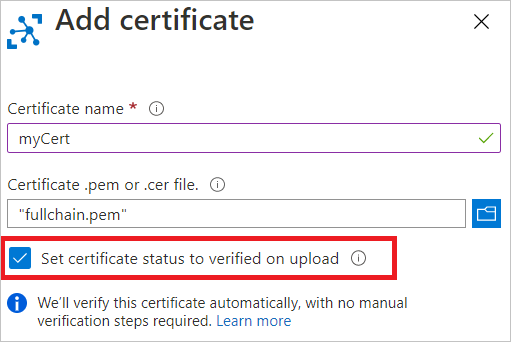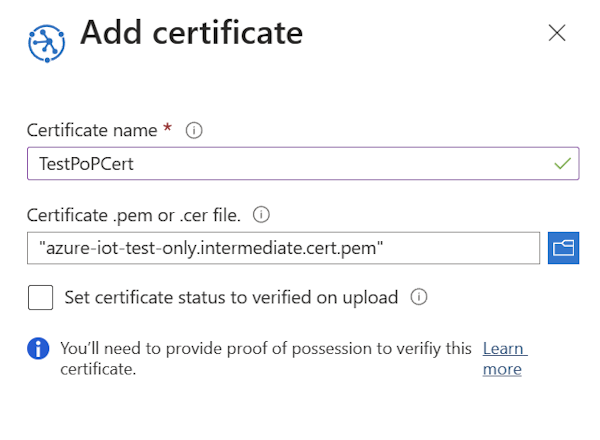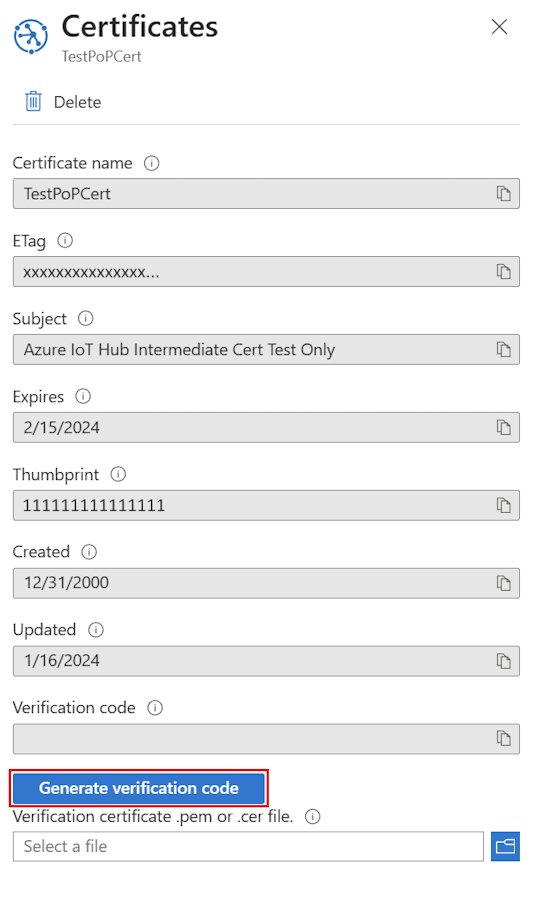Catatan
Akses ke halaman ini memerlukan otorisasi. Anda dapat mencoba masuk atau mengubah direktori.
Akses ke halaman ini memerlukan otorisasi. Anda dapat mencoba mengubah direktori.
A verified X.509 certificate authority (CA) certificate is a CA certificate that has been uploaded and registered to your provisioning service and then verified, either automatically or through proof-of-possession with the service.
Sertifikat terverifikasi memainkan peran penting saat menggunakan grup pendaftaran. Verifying certificate ownership provides an additional security layer by ensuring that the uploader of the certificate is in possession of the certificate's private key. Verifikasi mencegah pelaku jahat yang mengendus lalu lintas Anda untuk mengekstrak sertifikat perantara dan menggunakan sertifikat tersebut untuk membuat grup pendaftaran di layanan provisi mereka sendiri, dengan demikian membajak perangkat Anda. By proving ownership of the root or an intermediate certificate in a certificate chain, you're proving that you have permission to generate leaf certificates for the devices that will be registering as a part of that enrollment group. For this reason, the root or intermediate certificate configured in an enrollment group must either be a verified certificate or must roll up to a verified certificate in the certificate chain a device presents when it authenticates with the service. To learn more about X.509 certificate attestation, see X.509 certificates.
Prasyarat
Before you begin the steps in this article, have the following prerequisites prepared:
- A DPS instance created in your Azure subscription.
- A .cer or .pem certificate file.
Automatic verification of intermediate or root CA through self-attestation
If you are using an intermediate or root CA that you trust and know you have full ownership of the certificate, you can self-attest that you have verified the certificate.
Untuk menambahkan sertifikat terverifikasi otomatis, ikuti langkah-langkah berikut:
In the Azure portal, navigate to your provisioning service and select Certificates from the left-hand menu.
Pilih Tambahkan untuk menambahkan sertifikat baru.
Masukkan nama tampilan yang mudah diingat untuk sertifikat Anda.
Telusuri ke file .cer atau .pem yang mewakili bagian publik dari sertifikat X.509 Anda. Click Upload.
Centang kotak di samping Atur status sertifikat menjadi terverifikasi saat pengunggahan.

Pilih Simpan.
Your certificate is show in the certificate tab with a status Verified.

Manual verification of intermediate or root CA
Verifikasi otomatis disarankan saat Anda mengunggah sertifikat CA menengah atau akar baru ke DPS. However, you can still perform proof-of-possession if it makes sense for your IoT scenario.
Bukti kepemilikan melibatkan langkah-langkah berikut:
- Dapatkan kode verifikasi unik yang dihasilkan oleh layanan provisi untuk sertifikat CA X.509 Anda. Anda dapat melakukan ini dari portal Microsoft Azure.
- Buat sertifikat verifikasi X.509 dengan kode verifikasi sebagai subjeknya dan tanda tangani sertifikat dengan kunci privat yang terkait dengan sertifikat CA X.509 Anda.
- Unggah sertifikat verifikasi yang ditandatangani ke layanan. Layanan ini memvalidasi sertifikat verifikasi menggunakan bagian publik sertifikat CA untuk diverifikasi, sehingga membuktikan bahwa Anda memiliki kunci privat sertifikat CA.
Register the public part of an X.509 certificate and get a verification code
To register a CA certificate with your provisioning service and get a verification code that you can use during proof-of-possession, follow these steps.
In the Azure portal, navigate to your provisioning service and open Certificates from the left-hand menu.
Pilih Tambahkan untuk menambahkan sertifikat baru.
Enter a friendly display name for your certificate in the Certificate name field.
Select the folder icon, then browse to the .cer or .pem file that represents the public part of your X.509 certificate. Pilih Buka.
Once you get a notification that your certificate is successfully uploaded, select Save.

Your certificate will show in the Certificate Explorer list. Note that the status of this certificate is Unverified.
Select on the certificate that you added in the previous step to open its details.
In the certificate details, notice that there's an empty Verification code field. Select the Generate verification code button.

The provisioning service creates a Verification code that you can use to validate the certificate ownership. Copy the code to your clipboard.
Digitally sign the verification code to create a verification certificate
Now, you need to sign the verification code from DPS with the private key associated with your X.509 CA certificate, which generates a signature. This step is known as Proof of possession and results in a signed verification certificate.
Microsoft provides tools and samples that can help you create a signed verification certificate:
- The Azure IoT Hub C SDK provides PowerShell (Windows) and Bash (Linux) scripts to help you create CA and leaf certificates for development and to perform proof-of-possession using a verification code. You can download the files relevant to your system to a working folder and follow the instructions in the Managing CA certificates readme to perform proof-of-possession on a CA certificate.
- The Azure IoT Hub C# SDK contains the Group certificate verification sample, which you can use to do proof-of-possession.
The PowerShell and Bash scripts provided in the documentation and SDKs rely on OpenSSL. You may also use OpenSSL or other third-party tools to help you do proof-of-possession. For an example using tooling provided with the SDKs, see Create an X.509 certificate chain.
Upload the signed verification certificate
Upload the resulting signature as a verification certificate to your provisioning service in the Azure portal.
In the certificate details on the Azure portal, where you copied the verification code from, select the folder icon next to the Verification certificate .pem or .cer file field. Browse to the signed verification certificate from your system and select Open.
Once the certificate is successfully uploaded, select Verify. The status of your certificate changes to Verified in the Certificates list. Select Refresh if it does not update automatically.
Langkah berikutnya
- Untuk mempelajari tentang cara menggunakan portal untuk membuat grup pendaftaran, lihat Mengelola pendaftaran perangkat dengan portal Microsoft Azure.
- To learn about how to use the service SDKs to create an enrollment group, see Managing device enrollments with service SDKs.